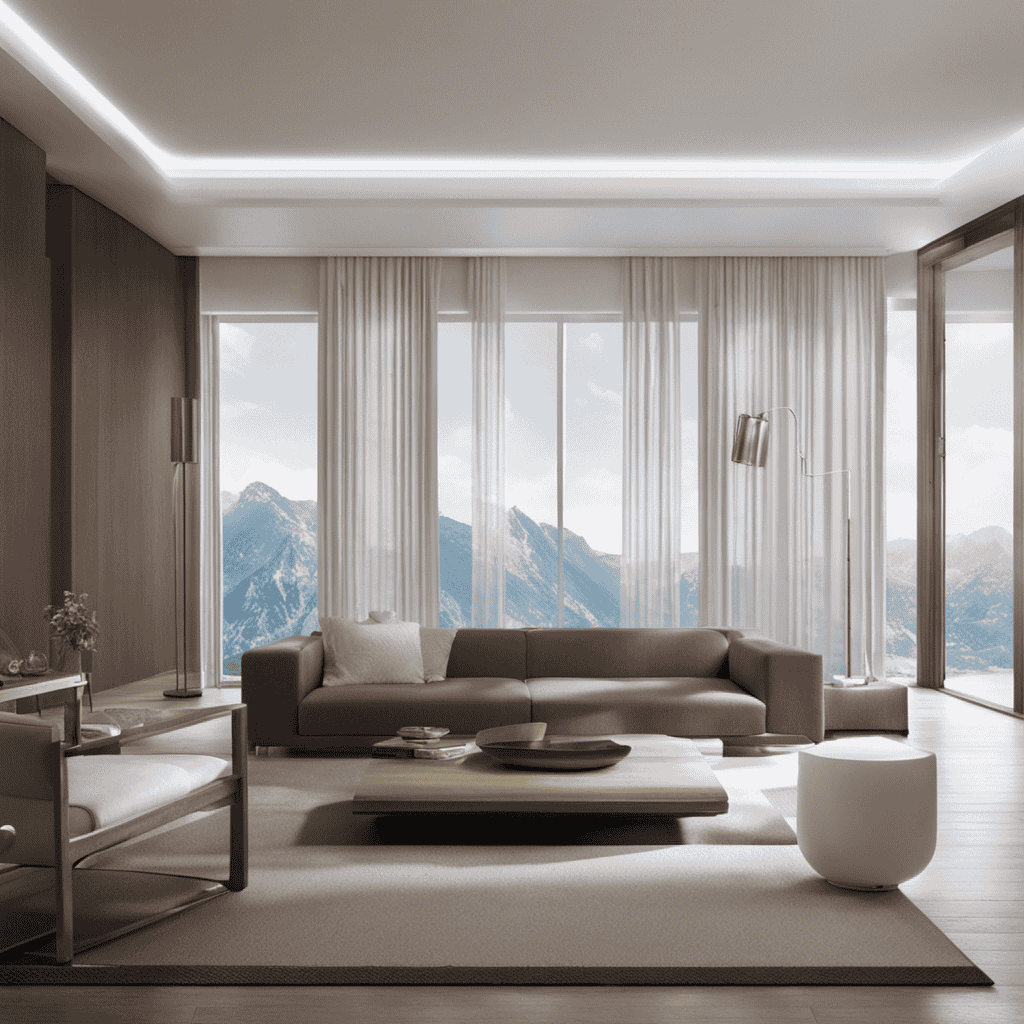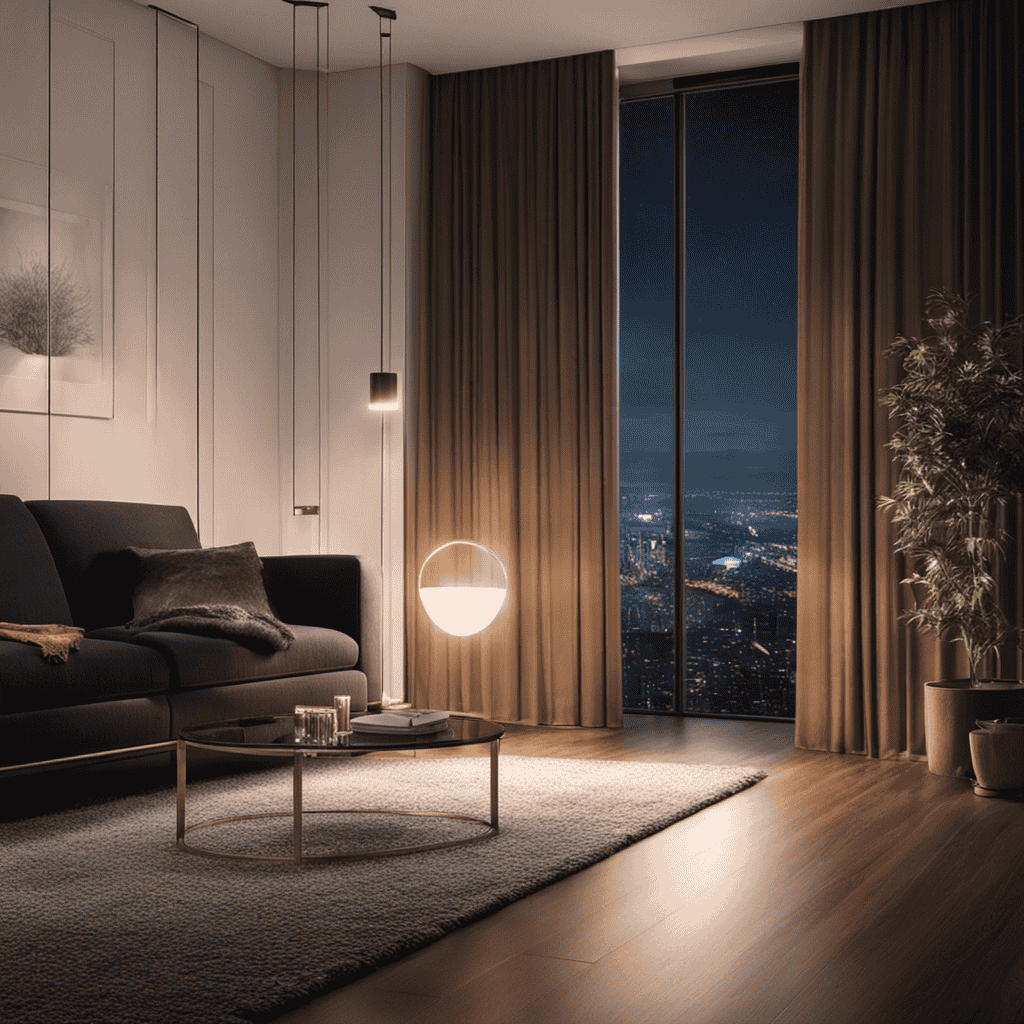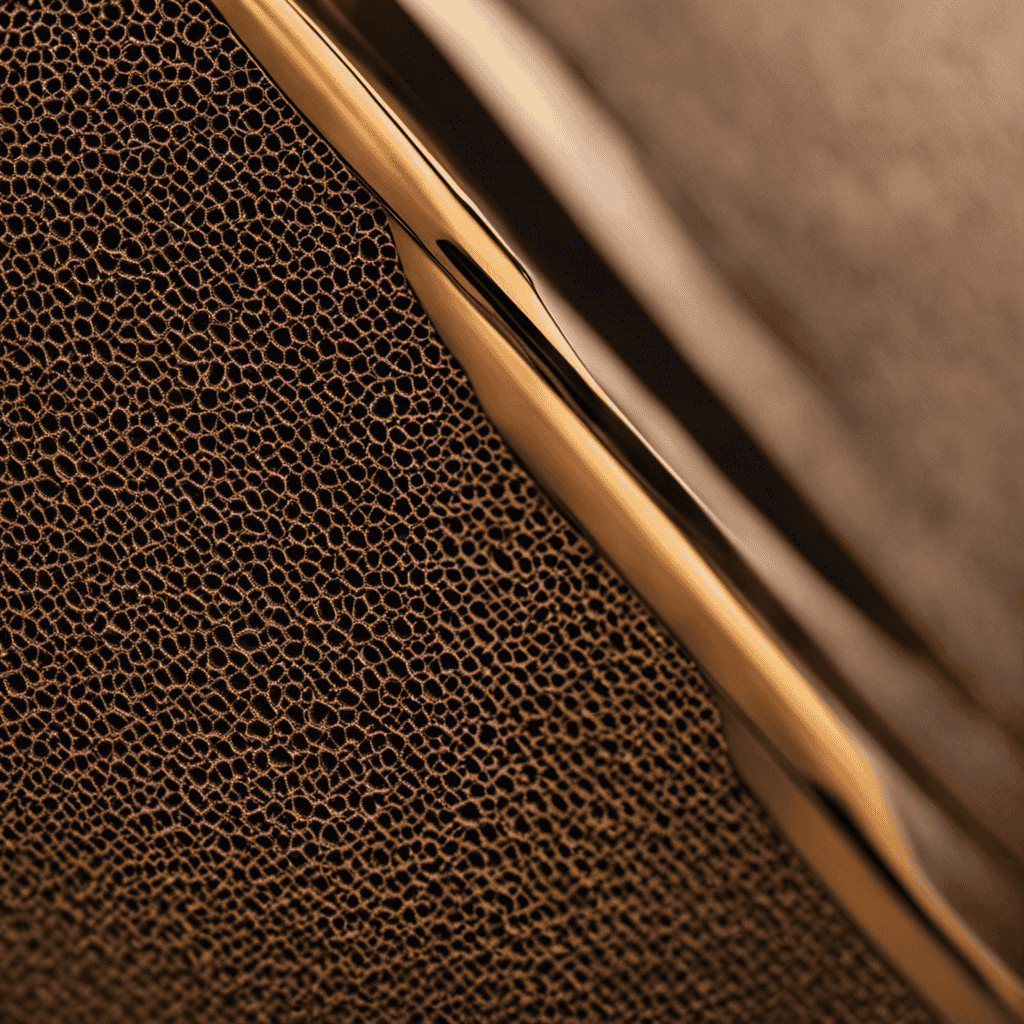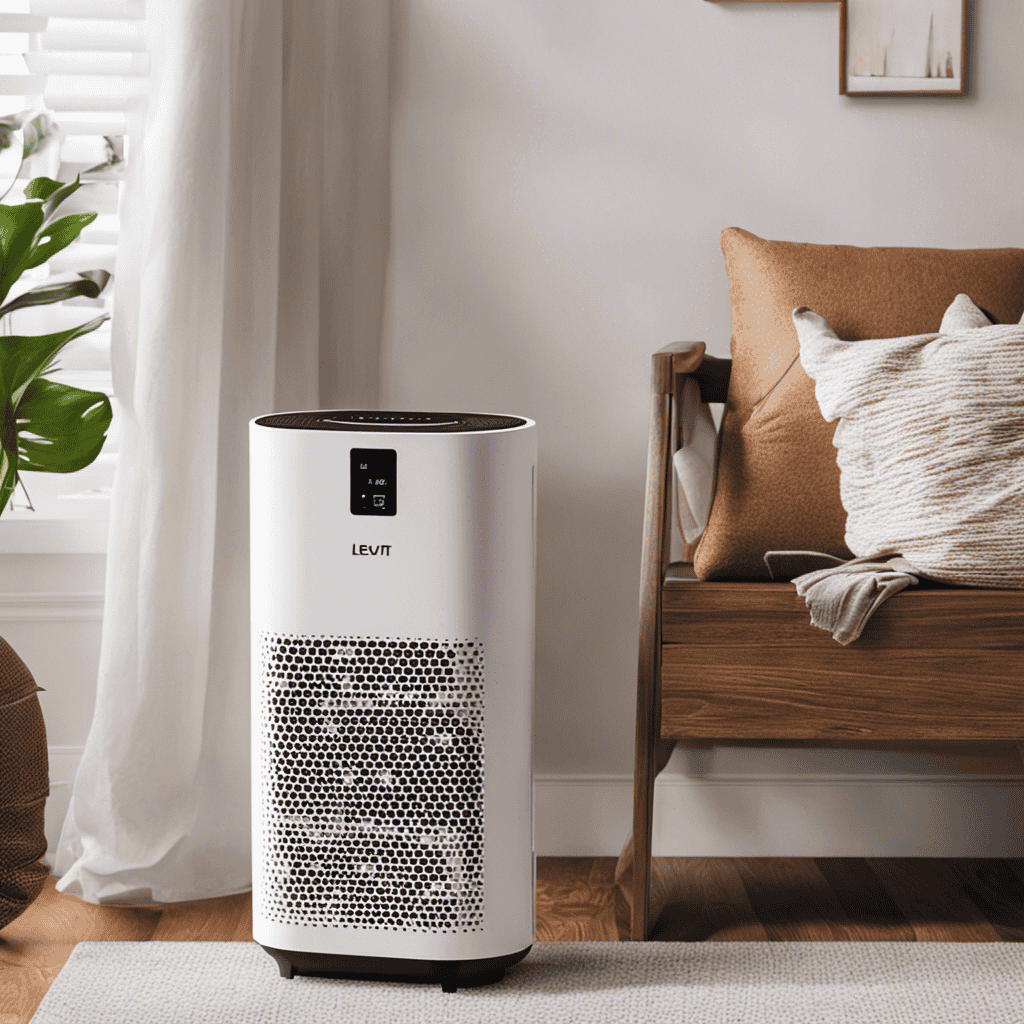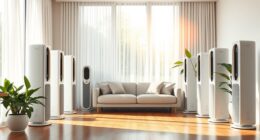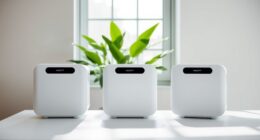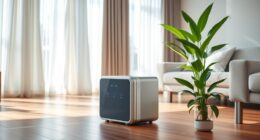Ever wondered how long it takes for an air purifier to clean the air? I have the answers you seek.
In this article, we’ll delve into the factors that affect air purifier cleaning time. We’ll explore the significance of air purifier CADR ratings and the role of different filter types.
Additionally, we’ll discuss how room size and placement play a crucial role in the effectiveness of air purifiers.
So, let’s dive in and uncover the secrets to optimizing air purifier cleaning efficiency.
Key Takeaways
- Room size is a crucial factor that determines the time required for effective air purification.
- The level of air pollution in the room also affects the cleaning time.
- CADR (Clean Air Delivery Rate) ratings help determine the effectiveness of an air purifier in removing dust, pollen, and smoke.
- The choice of filtration technology and speed settings greatly impacts the CADR ratings and overall air cleaning performance.
Factors Affecting Air Purifier Cleaning Time
Factors like the size of the room and the level of air pollution can affect how long it takes for your air purifier to clean the air. The size of the room is a crucial factor as it determines the volume of air that needs to be purified. Larger rooms will require more time for the air purifier to circulate and clean the air effectively.
Additionally, the level of air pollution in the room plays a significant role. If the air pollution is high, the air purifier will need more time to filter out the pollutants and improve the air quality.
On the other hand, air purifiers provide numerous benefits, including removing allergens, dust, and airborne particles, which can improve respiratory health and create a cleaner and healthier living environment.
Understanding Air Purifier CADR Ratings
When it comes to understanding air purifier effectiveness, one important factor to consider is the Clean Air Delivery Rate (CADR) rating. The CADR rating measures how quickly an air purifier can filter and clean the air in a room.
Interpreting CADR ratings can help determine the purifier’s ability to remove airborne particles such as dust, pollen, and smoke.
Choosing the right air purifier for your needs requires understanding and comparing CADR ratings to ensure optimal air cleaning performance.
Meaning of CADR Ratings
To understand the meaning of CADR ratings, you can look at how efficiently an air purifier can clean the air in your home. CADR, or Clean Air Delivery Rate, is a measurement that indicates the volume of clean air produced by an air purifier in a specific amount of time.
The importance of CADR ratings lies in their ability to provide consumers with a standardized metric to compare the effectiveness of different air purifiers. Factors that influence CADR ratings include the size of the room, the type of pollutants present, the filtration technology used, and the speed settings of the air purifier.
A high CADR rating means that the air purifier can clean the air faster and more effectively, making it a crucial factor to consider when choosing an air purifier for your home.
Interpreting Air Purifier Effectiveness
If you want to determine how well an air purifier works, you can easily interpret its effectiveness by looking at the CADR rating.
The CADR, or Clean Air Delivery Rate, measures the purifier’s ability to remove airborne particles such as dust, pollen, and smoke. It is a standardized metric that allows for easy comparison between different brands and models.
A higher CADR rating indicates a more efficient air purifier. When interpreting air quality, it is important to consider the CADR rating alongside other factors such as room size and filtration technology.
This will help you make an informed decision when comparing different brands and selecting the best air purifier for your needs. By using the CADR rating as a benchmark, you can confidently evaluate the effectiveness of air purifiers and improve the quality of the air in your space.
Choosing the Right Purifier
To choose the right purifier, consider factors such as room size, filtration technology, and your specific needs. When it comes to air purifiers, maintenance plays a crucial role in ensuring optimal performance. Regular cleaning and filter replacements are essential to keep the purifier functioning effectively.
To help you make an informed decision, here are some of the best air purifiers available:
-
Brand A: This purifier utilizes HEPA filtration technology, removing up to 99.97% of airborne particles, including dust, pollen, and pet dander.
-
Brand B: Equipped with activated carbon filters, this purifier effectively eliminates odors, smoke, and harmful gases.
-
Brand C: Utilizing a combination of HEPA and UV-C technology, this purifier not only captures particles but also kills airborne germs and bacteria.
-
Brand D: Designed for large rooms, this purifier offers powerful filtration, ensuring clean and fresh air throughout the space.
Consider your room size, filtration needs, and maintenance requirements to find the best air purifier for your specific needs.
The Role of Filter Types in Air Purifier Efficiency
The role of filter types in air purifier efficiency can greatly impact the overall performance and effectiveness of the device. When it comes to filter effectiveness, the type of filter used plays a crucial role in capturing and removing airborne particles from the air.
High-quality filters, such as HEPA filters, are known for their exceptional ability to trap even the smallest particles, improving air quality significantly. These filters are designed to capture particles as small as 0.3 microns with an efficiency of 99.97%.
By removing allergens, dust, pollen, and other pollutants, air purifiers with effective filters contribute to a cleaner and healthier indoor environment.
As we delve into how room size impacts air purifier cleaning time, it is important to understand how filter types work in conjunction with the device’s performance.
How Room Size Impacts Air Purifier Cleaning Time
When it comes to air purifiers, the size of the room plays a crucial role in determining the cleaning time. In small rooms, the air purifier can clean the air at a faster rate due to the limited space it needs to cover.
However, in larger rooms, the cleaning time is prolonged as the air purifier requires more time to circulate and filter the air effectively. Therefore, finding the optimal room size for an air purifier is essential to ensure efficient and timely air cleaning.
Small Rooms, Faster Cleaning
Air purifiers can clean small rooms more quickly. With their faster filtration capabilities and compact design, these devices efficiently remove airborne contaminants in no time. Here’s how they do it:
- High-speed fans circulate the air, creating a constant flow that maximizes filtration efficiency.
- The filters, such as HEPA or activated carbon filters, capture particles and pollutants as small as 0.3 microns.
- The compact design ensures that the air purifier can cover the entire room, reaching every corner.
- Advanced sensors detect the air quality in real-time, allowing the device to adjust its cleaning speed accordingly.
By combining these features, air purifiers optimize their cleaning process and provide cleaner air in small rooms faster.
Large Rooms, Longer Time
Covering a large room with an air purifier may require more time than cleaning a small room. The optimal room size for an air purifier to effectively clean the air varies depending on the specific model and its capabilities.
In general, larger rooms tend to have a higher volume of air, which means it takes longer for the air purifier to cycle through and filter the entire room. The larger the room, the more time it may take for the air purifier to clean the air to the desired level of purity.
This is because the air purifier needs to capture and remove a greater amount of airborne particles and pollutants. Therefore, if you have a large room, it’s important to choose an air purifier that is suitable for that size to ensure optimal air cleaning efficiency.
Optimal Room Size
If you have a large room, you’ll want to consider the optimal size of an air purifier. The room size plays a crucial role in determining the effectiveness of an air purifier in improving air quality.
Here are some key points to consider:
-
Coverage Area: An air purifier’s coverage area determines how much space it can effectively clean. A larger room requires a purifier with a higher coverage area to ensure efficient air purification.
-
Air Exchange Rate: The air exchange rate refers to the number of times the air in a room is completely filtered per hour. A higher air exchange rate is essential for larger rooms to ensure faster and more thorough air purification.
-
CADR: Clean Air Delivery Rate (CADR) is a measure of how efficiently an air purifier removes pollutants from the air. Choosing an air purifier with a high CADR is important for maintaining good air quality in a large room.
-
Fan Speeds: Different air purifiers offer varying fan speeds. In larger rooms, it is recommended to select a purifier with multiple fan speeds to adjust the airflow according to your needs.
Considering these factors will help you choose the optimal size of an air purifier for your large room, ensuring effective air purification and improved air quality.
The Importance of Air Purifier Placement for Effective Cleaning
Proper placement of an air purifier is crucial for it to effectively clean the surrounding environment. The strategic positioning of the air purifier impacts its ability to remove pollutants and improve air quality. To illustrate this, consider the following table:
| Placement Location | Effectiveness |
|---|---|
| Near the source of pollution | Highly effective in capturing pollutants emitted at the source. |
| In the center of the room | Efficiently circulates purified air throughout the space. |
| Close to walls or corners | Helps capture airborne particles that may settle in these areas. |
| Away from obstructions | Ensures unobstructed airflow for optimal performance. |
Comparing Air Purifier Performance for Different Pollutants
Placing the air purifier near the source of pollution effectively captures pollutants emitted directly from the source.
Air purifiers have evolved significantly due to advancements in technology, offering improved performance and efficiency.
When comparing air purifier brands, it is important to consider their ability to effectively remove different types of pollutants. Here are some key factors to consider:
-
HEPA Filtration: High-Efficiency Particulate Air (HEPA) filters are capable of capturing particles as small as 0.3 microns, including dust, pollen, and pet dander.
-
Activated Carbon Filters: These filters target odors, gases, and volatile organic compounds (VOCs) by adsorbing them onto the carbon surface.
-
UV-C Light: Some air purifiers use ultraviolet (UV) light to kill bacteria, viruses, and mold spores, providing an added layer of protection.
-
Smart Features: Many modern air purifiers offer smart features such as air quality sensors, automatic mode adjustments, and mobile app control, enhancing convenience and effectiveness.
The Impact of Air Purifier Fan Speed on Cleaning Time
The impact of adjusting the air purifier fan speed on cleaning time can be significant. When the fan speed is set to a higher level, the air purifier can clean the air more quickly. However, this may also result in increased noise, which can have a negative impact on the user experience.
It is important to find a balance between cleaning efficiency and noise level, especially in commercial spaces where people may be working or conducting business.
Air purifiers offer several benefits in commercial spaces, including removing allergens, pollutants, and odors, creating a healthier and more comfortable environment for employees and customers.
In order to optimize air purifier cleaning efficiency, there are several tips to consider, which will be discussed in the next section.
Tips for Optimizing Air Purifier Cleaning Efficiency
One way to optimize the efficiency of your air purifier is by adjusting the fan speed. By finding the right balance, you can improve the effectiveness and maximize the performance of your air purifier. Here are some tips to help you get the most out of your device:
- Set the fan speed to high during peak pollution hours to quickly clean the air and remove pollutants.
- Use the medium fan speed setting for everyday use, as it provides a good balance between air cleaning and noise level.
- When the air is relatively clean, you can switch to the low fan speed setting to conserve energy and reduce noise.
- Consider using the turbo or boost mode for intense air cleaning sessions, such as when cooking or during allergy season.
Is the Time it Takes for an Air Purifier to Clean a Room the Same as Cleaning the Air Overall?
The air purifier cleaning time for a room varies from the overall air cleaning time. The air purifier can efficiently clean the air in a room within a few hours, but it may take longer to clean the air overall in the entire house.
Frequently Asked Questions
Can an Air Purifier Completely Eliminate All Types of Indoor Pollutants?
An air purifier is effective in reducing indoor pollutants, but it has limitations. While it can eliminate many types of pollutants like dust and pet dander, it may not be able to eliminate all types of pollutants completely.
Can an Air Purifier Remove Odors From the Air?
Yes, an air purifier can remove odors from the air. It is important to consider the effectiveness of the specific air purifier and to regularly maintain it for optimal performance.
How Often Do Air Purifier Filters Need to Be Replaced?
Air purifier filters need to be replaced regularly to maintain optimal performance. The frequency depends on factors such as the type of filter, air quality, and usage. It is essential to follow manufacturer guidelines for the recommended replacement schedule.
Can an Air Purifier Help With Respiratory Conditions Such as Asthma or Allergies?
An air purifier can be effective in reducing respiratory symptoms caused by asthma or allergies. Regular maintenance, such as filter replacement, is necessary to ensure optimal performance.
Are There Any Potential Health Risks Associated With Using an Air Purifier for Long Periods of Time?
Using an air purifier for long periods of time may have potential side effects, but the exact long-term effects are not well understood. Further research is needed to determine any health risks associated with prolonged use.
Conclusion
In conclusion, the time it takes for an air purifier to clean the air depends on various factors. These factors include CADR ratings, filter types, room size, placement, and fan speed. One interesting statistic to note is that air purifiers with higher CADR ratings are able to clean the air more quickly. For example, a purifier with a CADR rating of 300 can clean a 300 square foot room in just 20 minutes.
By understanding and optimizing these factors, we can maximize the efficiency of air purifiers in creating cleaner and healthier indoor environments.
